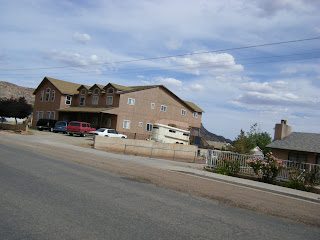
June 18, 2009
This morning I walked down the street to get coffee while Jes slept in and stumbled into a fantastic café. I booted up my little netbook and sipped from a cup of tasteful and aromatic coffee while sitting amidst a desert garden, listening to the miniature waterfall in a little Japanese pond that three big multicolored goldfish called home.
Our plan was to drive south on Hwy 191 to Blanding, and then cut west on 95 and then south on 261. We bucked a headwind all the way south to Blanding, which is located on a kind of mesa, right at 6,100 feet. We still wore jackets and gloves, but no rain gear needed, thank god.
When we turned onto 95, I knew it was a good choice, because we saw nobody on the road that swooped through the canyons like a hawk. The road required constant shifting, but that was just fine because it was so nice. Along the way, we stopped at some Anasazi ruins. Jes and I both commented how so very exciting it was to gaze upon a place that was bustling with activity 800 years ago.


We turned south and the first thing we saw was a sign that said, “Narrow gravel road 23 miles ahead.” I’m thinking, “Huh? WTF? Two years ago I had driven this same route the other direction, and I just didn’t seem to recall anything special. Oh, well.
But, 23 miles later it all came back to me…we would be driving right down the side of a mesa bluff into the area just north of Monument Valley. Two years ago I had driven toward this wall of red stone thinking, “Where’s the road up?” I think the pictures will show exactly what it was like.

This picture was taken looking over the back...this is the rock wall we had just driven down!

Once down, we stopped in Mexican Hat, shared a burger, and saddled up again, looking forward to Monument Valley, the site of filming for many John Wayne movies.
What is amazing about the buttes of Monument Valley is that the whole valley floor used to be the same height as the top of the monuments. Wind and water subsequently worn down and carried away all the softer rock, leaving the harder stone behind, standing in tall spires.

A traffic accident put us on a detour in Kayenta, a town in the Navajo Nation, and we were stop and go…mostly stop. At one point, when I let the clutch out, a hammer of wind hit us…so hard that it ACTUALLY PUSHED US BACKWARDS ON THE HARLEY. I swear to god we rolled backwards a few feet while I fought for balance. I didn’t want to gas it and go because I wasn’t sure if I could stay upright, so I just locked the front brake and braced my feet on the ground. Then, suddenly as it came, it was gone. I said to Jes, “Shit! That was as strong or stronger than the wind burst we hit yesterday.” (The day before, after the final gas stop while on the way to Moab, we had just gotten back on I-40 when we were hit by a gust of wind that felt solid as a fist.) Later, Jes told me, “Yeah, I was filming and saw the dust storm coming.” I’m like, What? Why the F didn’t you tell me!”
Later, when we reviewed her video recording, it was clear what had happened: a very big dust devil had blown our way and passed over us. Fortunately, we were stopped when it hit, because a Harley is fine when moving right along, fine when stopped, but there is a moment of transition when beginning to roll when balance is a little iffy.
At Kayenta, after we checked in, a group of Harley riders pulled into the Holiday Inn. Turns out they were Italians who owned Harleys back in Italy and who had rented them in Las Vegas and were doing a tour. They even had Italian Harley leather jackets on! One of them said,"Everything is bigger here...even the Cokes." And, yes, ALL of them, men and women, young and middle-aged, were NOT carrying pounds and pounds of extra weight. Go figure.
As usual, supper, download pictures, discuss tomorrow…which, in this case, will our last day on the Harley.
Mike Sledge
























